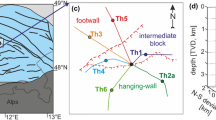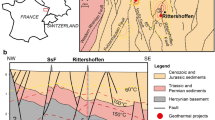Abstract
In order to determine the most suitable location for a complex of rock caverns, the fracturing of a rapakivi granite block was studied in three dimensions. Five vertical, 200 m deep boreholes (Ø=66 mm) were drilled for this purpose.
The selection of the geophysical measurements, which are utilized for this fracture classification is based on the results of the previous geophysical investigations in the test holes.
The connections between the boreholes are evaluated from dipmeter data, crosshole-seismic data and from charged potential cross-correlation data. The hydraulic conductivities of fracture zones and rock-blocks between them and the fracture apertures are calculated from water injection test data.
Résumé
Pour choisir l'emplacement le mieux adapté à l'implantation de cavités souterraines, l'étude tridimensionnelle de la fracturation d'un granite de Rapakivi a été entreprise. Cinq sondages verticaux d'une profondeur de 200 mètres (diamètre: 66 mm) on été réalisés dans ce but.
Le choix des mesures géophysiques utilisées est fondé sur des recherches préliminaires réalisées dans des forages d'essai.
Les corrélations entre forages sont faites au travers des données inclinométriques, des mesures sismiques entre forages et
La conductivité hydraulique des zones fracturées et des blocs rocheux, ainsi que l'ouverture des fractures sont calculées à partir des résultats des essais d'injection d'eau.
Similar content being viewed by others
References
ANTTILA P., GARDEMEISTER R., ROUHIAINEN P. (1982): Final disposal of nuclear wastes, Loviisa Power Plant site, Preliminary studies of granitic bedrock, report YJT-82-23 (in Finnish), 38 p.
BROWN P.A., REY N.A.C., McEVEN J.H., LAU J.S.O. (1982): The role of fracture characterization in data synthesis modelling. Atomic Energy of Canada Limited, TR-191, 89 p., Pinawa, Manitoba.
COSMA C. (1983): Determination of rock mass quality by the crosshole seismic mthod. Bull. of, YAEG, No 26-27, pp. 219–225.
GARDEMEISTER R., ROUHIAINEN P. (1984): Investigations for final disposal of reactor waste at Loviisa power plant site, Finland. IAEA-SR-104/4, Seminar on the site investigation techniques and assessment methods for underground disposal of radioactive wastes, 19 p., Sofia.
HÄRME M., (1982): Lithological map, sheet C1…D1 Helsinki, 1:400 000 (in Finnish), Helsinki.
IMATRAN VOIMA OY. (1981): Preliminary surface fracture mapping Loviisa Power Plant. Research report, RM-8271.40 (in Finnish), 4 p., Helsinki.
KUIVAMÄKI A., TUOMINEN H.V. (1985): Seismotectonic inter pretation of Loviisa Area, Report (in Finnish), Helsinki.
MOYE D.G. 1967: Diamond drilling for fundations. Australian Civil Engineering Transaction, CE 9 n:o 1, pp. 95–100.
PARKKINEN J., HUOMO P. (1978): Wyborg massif, structure interpretation (in Finnish). Geological Journal, Geologi, pp. 57…62., Otaniemi.
POIKONEN A., HASSINEN P. (1983): Suitability of bedrock of Loviisa Power Plant site for final disposal of reactor waste. Supplementary geophysical studies, YJT-83-05, 18 p., Helsinki.
ROUHIAINEN P. (1984): Geophysical borehole logging. Nuclear Waste Commission of Finnish Power Companies (YJT), report (in Finnish) YJT-84-01, 55 p.
SAARI K., HOLOPAINEN P., PIRHONEN V., POIKONEN A. (1984): Hydraulic properties of granitic rock and their measurement. Nuclear Waste Commission of Finland (YJT), report YJT-84-15 (in Finnish), 140 p., Helsinki.
SAKSA P. (1984): Radiometric electrical and acoustic geophysical borehole studies of the Loviisa Power Plant site, in 1983. Nuclear Waste Commission of Finnish Power Companies, report YJT-84-02, 40 p., Helsinki.
SUOMINEN V. (1980): Fracturing of bedrock at Hästholmen, Loviisa. Geological Survey of Finland, report GTL/YSP 13 (in Finnish), 17 p.
SUOMINEN V. (1983): Geological structure of bedrock in Hästholmen, Loviisa: Summary of geological studies in core drilling holes Y1…Y11. Nuclear Waste Commission of Finnish Power Companies (YJT) (in Finnish, summary in English), Report YJT-83-03, 23 p., Helsinki.
VORMA A. (1980): The Wyborg rapakivi massif: Precambrian bedrock of southern and eastern Finland. 26th International Geologicla Congress, Guide excursions 004 A+C, Ed. Kai Hytönen, pp. 6…8, Paris.
Author information
Authors and Affiliations
Rights and permissions
About this article
Cite this article
Pirhonen, V.O. Siting a rock cavern complex by means of 3-D fracture structure of a granite block. Bulletin of the International Association of Engineering Geology 34, 67–72 (1986). https://doi.org/10.1007/BF02590237
Issue Date:
DOI: https://doi.org/10.1007/BF02590237




